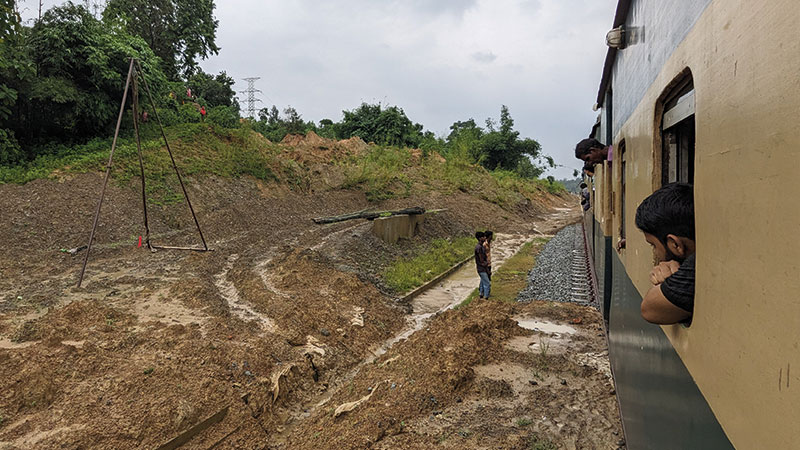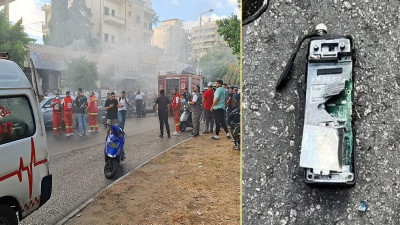 Flooding and heavy rain caused multiple landslides in Cox’s Bazar, filling large sections of the Dohazari-Cox’s Bazar railway with debris. Photo: Staff Photographer
Flooding and heavy rain caused multiple landslides in Cox’s Bazar, filling large sections of the Dohazari-Cox’s Bazar railway with debris. Photo: Staff Photographer Despite
the railway between Dohazari and Cox’s Bazar not being fully completed, it was
opened in a limited capacity in December 2023. However, after two consecutive
years of heavy rains, repeated floods and landslides have made the railway
increasingly hazardous. Experts are now saying that the effects of constructing
the railway without regard for nature are beginning to show.
In
August 2023, parts of the under-construction Chattogram-Cox’s Bazar railway
line were damaged by continuous rain and mountain runoff. In the Keochia
Temuhani area of Satkania, 450 meters of track sank due to the shifting of soil
and rock. Local residents claimed that the construction of the railway
contributed to the most severe flooding in memory for that area. Along with the
residents, railway officials and experts warned that unplanned construction of
the railway could lead to prolonged flooding. Following that flood, the railway’s
design was altered, with additional culverts and bridges being constructed.
Although this rainy season has not seen flooding or waterlogging around the
railway, a new crisis has emerged: landslides. In multiple incidents,
landslides have caused sections of the track in the Chunati Wildlife Sanctuary
to become buried. Railway officials have acknowledged that this new threat has
introduced additional risks for the Cox’s Bazar railway line.
According
to railway sources, heavy rains across the country on August 22 triggered
landslides on the Dohazari-Cox’s Bazar railway line in the eastern region. As a
safety precaution, train service to Cox’s Bazar was suspended for several days.
Even though train services resumed a few days after clearing the debris,
another landslide occurred on Sunday afternoon (September 15). With repeated
landslides making the railway in the Chunati Wildlife Sanctuary increasingly
dangerous, concerns about the construction project have escalated. The root
cause of the repeated landslides lies in unregulated and unscientific hillside
cutting to build the railway, insufficient culvert and bridge construction over
the railway, inadequate retaining walls along the track, and a lack of measures
to restore hills that were cut. Additionally, defying environmental department
restrictions, soil from hill cutting was used for railway construction, further
destabilizing the area.
Industry
insiders have noted that soil cut from hills in various parts of Lohagara
Upazila was used for embankment construction along the railway line. This
practice has led to an increase in landslides across the region during the
monsoon season. Landslides have also altered the natural courses of streams and
canals, causing water flow issues. The culverts and bridges constructed in the
affected areas were not designed to handle the water flow, leading to further
disruptions. In Aziznagar, an area in the Chunati Wildlife Sanctuary,
approximately 400 meters of railway is flanked by cut hills, which collapse
during rain, creating obstacles on the track. Although siding walls have been
built in limited sections of this area, they are insufficient. In the latest
landslides, these walls were destroyed, burying the track under soil. The
railway authority has instructed the contractor to construct higher retaining
walls in this area.
Local
residents have pointed out that the Chattogram-Cox’s Bazar highway was
constructed in harmony with the surrounding hilly terrain. As a result, the
highway has not faced significant damage or prolonged waterlogging, even during
heavy rains or floods. The highway has not been a factor in recent flooding or
waterlogging. However, the railway, which was built without sufficient
adaptation to the hilly terrain, has seen an increase in floods and landslides.
The railway’s raised embankment has also slowed water drainage in various areas
compared to the highway. Inadequate culverts and the blockage of natural water
flow paths during railway construction have caused landslides and water
accumulation along the railway.
Following
two recent landslides, project authorities were instructed to construct robust
guide walls or protective walls at the accident sites. In response, the
contractor, Toma Construction Limited, has begun work on a
three-to-four-foot-high wall over a 100-meter stretch (77/57 kilometers). Additionally,
geo-technology will be used to plant specialized grass on approximately 400
meters of the cut hills in the area to prevent future landslides. With the
project’s deadline extended by one month, officials from the contractor and
project have stated that these measures will be implemented within the original
budget by October to prevent future landslides and waterlogging along the
railway.
Railway
authorities have reported that prior to the implementation of the Dohazari-Cox’s
Bazar railway project, detailed surveys on the soil and biodiversity of the
hilly regions were not conducted. Due to a lack of sufficient studies on the
quality, fragility, and water flow patterns of the region’s soil, various
problems have surfaced as the project nears completion. Unregulated
hill-cutting on both sides of the railway, coupled with the use of soil from
hill cutting to construct railway track embankments, has obstructed the natural
water flow. This has led experts to believe that, despite building retaining
walls, incidents of landslides and flooding will increase. They argue that the
inconsistency in the catchment areas for water flow near culverts and bridges
along the railway route has caused these issues.
Bimal
Shaha, Project Director of Toma Construction & Company Limited, told Bonik
Barta, “In several areas from Dohazari to Chakaria, the railway track has been
constructed on hilly land. As the project is still incomplete, various issues
have emerged during the monsoon season. We have already taken measures, with input
from experts, to prevent further landslides and waterlogging. In addition to
building high walls on both sides, we will plant grass on the hills. These
measures will be completed within the repair period, even after the project’s
completion.”
In
2013-14, an Environmental Impact Assessment (EIA) was conducted for the
construction of the Dohazari-Cox’s Bazar railway. The consultant firm held
meetings with local administrations, union councils, farmers, fishers, and
departments such as local government engineering, coastal forestry, agriculture
extension, wildlife conservation, and the environment department. However,
local officials from the Water Development Board (WDB) have claimed that their
organization was not involved in the meetings. During the EIA, local
stakeholders also raised concerns about the potential for flooding and landslides
caused by hill-cutting.
Project
officials stated that in response to local demands, the number of culverts has
been increased. Originally, the design called for 144 culverts along the
railway, but due to local demands, this number has been raised to 173. After
the 2023 floods, four additional culverts were constructed in the Keochia area
of Satkania, among other areas. Officials acknowledged that the construction of
extra culverts and bridges outside the original design has highlighted
engineering inefficiencies in the project’s implementation.
Mohammad
Suboktagin, Director of the Dohazari-Cox’s Bazar Railway Project, told Bonik
Barta, “While multiple new railways have been constructed across the country,
the Dohazari-Cox’s Bazar railway is entirely different. Due to the
topographical and geomorphological structure of the hilly land, the project has
faced several challenges. We are working to address these issues as we encounter
them during implementation. We hope that once the project is fully completed,
the current problems, including landslides, will no longer persist.”
Experts
believe that the terrain of the Chattogram-Cox’s Bazar region is unique
compared to the rest of the country. While water generally flows from north to
south in Bangladesh, in this region, the water flows from east to west. They
stress the urgency of conducting a comprehensive study to rectify existing
defects in the railway, considering the region’s heavy rainfall and hilly
floods.
Mohammad
Saiful Islam, Divisional Railway Manager of the Eastern Railway, told Bonik
Barta, “The construction of the Dohazari-Cox’s Bazar railway is not officially
complete. Recently, landslides in the Lohagara area brought soil onto the
railway in two incidents. We have informed the project authority about these
issues and are planning to send a proposal and guidelines for permanent
landslide prevention measures. It will be instructed in a letter to complete
these works within the project timeline.”






